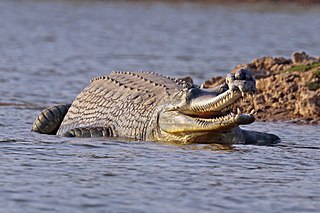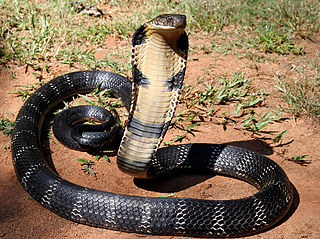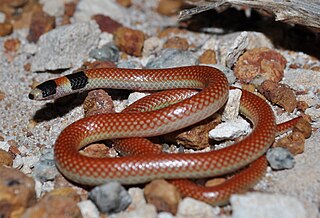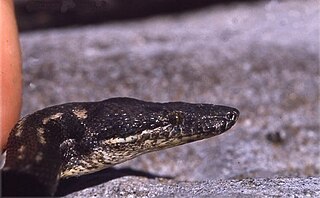 W
WThe Mexican blind lizard is a species of legless lizard in the family Dibamidae, and the only species in the genus Anelytropsis. It is endemic to Mexico. They look like Amphisbaenia, but are in fact, only distantly related.
 W
WThe black caiman is a species of large crocodilian and, along with the American alligator, is one of the biggest extant members of the family Alligatoridae and order Crocodilia. It is a carnivorous reptile that lives along slow-moving rivers, lakes, seasonally flooded savannas of the Amazon basin, and in other freshwater habitats of South America. It is a large species, growing to at least 5 m (16 ft) and possibly up to 6 m (20 ft) in length, which makes it the fourth-largest reptile in the Neotropical realm, behind the American alligator, American crocodile, and the critically endangered Orinoco crocodile. As its common and scientific names imply, the black caiman has a dark coloration, as an adult. In some individuals, the dark coloration can appear almost black. It has grey to brown banding on the lower jaw. Juveniles have a more vibrant coloration compared to adults with prominent white to pale yellow banding on the flanks that remains present well into adulthood, at least more when compared to other species. The morphology is quite different from other caimans but the bony ridge that occurs in other caimans is present. The head is large and heavy, an advantage in catching larger prey. Like all crocodile-like animals, caimans are long, squat creatures, with big jaws, long tails and short legs. They have thick, scaled skin, and their eyes and noses are located on the tops of their heads. This enables them to see and breathe while the rest of their bodies are underwater.
 W
WThe tentacled snake or tentacle snake is a rear-fanged aquatic snake native to South-East Asia. It is the only species of its genus, Erpeton, and the two tentacles on its snout are a unique feature among snakes.
 W
WThe gharial, also known as the gavial or the fish-eating crocodile, is a crocodilian in the family Gavialidae and among the longest of all living crocodilians. Mature females are 2.6–4.5 m long, and males 3–6 m. They have a distinct boss at the end of the snout, which resembles an earthenware pot known as a ghara, hence the name "gharial". The gharial is well adapted to catching fish because of its long, thin snout and 110 sharp, interlocking teeth.
 W
WThe greater earless lizard is a species of earless lizard endemic to the Southwestern United States.
 W
WThe king cobra is an elapid endemic to forests from India through Southeast Asia. It is threatened by habitat destruction and has been listed as Vulnerable on the IUCN Red List since 2010. It is the world's longest venomous snake. Adult king cobras are 3.18 to 4 m long on average. The longest known individual measured 5.85 m (19.2 ft). It is the sole member of the genus Ophiophagus. It preys chiefly on other snakes and occasionally on some other vertebrates, such as lizards and rodents. It is a highly venomous and dangerous snake when agitated or provoked that has a fearsome reputation in its range, although it is typically shy and avoids confrontation with humans when possible. The king cobra is a prominent symbol in the mythology and folk traditions of India, Sri Lanka and Myanmar. It is the national reptile of India.
 W
WThe marine iguana, also known as the sea iguana, saltwater iguana, or Galápagos marine iguana, is a species of iguana found only on the Galápagos Islands (Ecuador). Unique among modern lizards, it is a marine reptile that has the ability to forage in the sea for algae, which makes up almost all of its diet. Large males are able to dive to find this food source, while females and smaller males feed during low tide in the intertidal zone. They mainly live in colonies on rocky shores where they bask after visiting the relatively cold water or intertidal zone, but can also be seen in marshes, mangrove and beaches. Large males defend territories for a short period, but smaller males have other breeding strategies. After mating, the female digs a nest hole in the soil where she lays her eggs, leaving them to hatch on their own a few months later.
 W
WThe black caiman is a species of large crocodilian and, along with the American alligator, is one of the biggest extant members of the family Alligatoridae and order Crocodilia. It is a carnivorous reptile that lives along slow-moving rivers, lakes, seasonally flooded savannas of the Amazon basin, and in other freshwater habitats of South America. It is a large species, growing to at least 5 m (16 ft) and possibly up to 6 m (20 ft) in length, which makes it the fourth-largest reptile in the Neotropical realm, behind the American alligator, American crocodile, and the critically endangered Orinoco crocodile. As its common and scientific names imply, the black caiman has a dark coloration, as an adult. In some individuals, the dark coloration can appear almost black. It has grey to brown banding on the lower jaw. Juveniles have a more vibrant coloration compared to adults with prominent white to pale yellow banding on the flanks that remains present well into adulthood, at least more when compared to other species. The morphology is quite different from other caimans but the bony ridge that occurs in other caimans is present. The head is large and heavy, an advantage in catching larger prey. Like all crocodile-like animals, caimans are long, squat creatures, with big jaws, long tails and short legs. They have thick, scaled skin, and their eyes and noses are located on the tops of their heads. This enables them to see and breathe while the rest of their bodies are underwater.
 W
WThe Mexican blind lizard is a species of legless lizard in the family Dibamidae, and the only species in the genus Anelytropsis. It is endemic to Mexico. They look like Amphisbaenia, but are in fact, only distantly related.
 W
WNeelaps is a genus of snake in the family Elapidae that contains the species Neelaps calonotus and Neelaps bimaculatus.
 W
WOreocryptophis porphyraceus is a rat snake species, commonly called the black-banded trinket snake, red bamboo snake, Thai bamboo rat snake or red mountain racer, found in mid to upper-level elevations of forested hills in southeastern Asia, ranging from evergreen tropical to dry seasonal forests depending on the subspecies and locality. It is the only member of the genus Oreocryptophis, but it was formerly placed in Elaphe.
 W
WThe dwarf crocodile, also known as the African dwarf crocodile, broad-snouted crocodile or bony crocodile, is an African crocodile that is also the smallest extant (living) species of crocodile. Sampling has identified three genetically distinct populations. Some feel that the findings should elevate the subspecies to full species status.
 W
WRhineura floridana, known commonly as the North American worm lizard, Florida worm lizard, graveyard snake, or thunderworm, is a species of amphisbaeninan in the family Rhineuridae. The species is the only member of the monotypic genus Rhineura, and is found primarily in Florida but has been recorded in Lanier County, Georgia. There are no subspecies that are recognized as being valid.
 W
WThe Round Island boa, also known as the Round Island keel-scaled boa and the Round Island ground boa, is a species of nonvenomous snake in the monotypic genus Casarea in the family Bolyeriidae. The species is endemic to Round Island, Mauritius. No subspecies are currently recognized.
 W
WThe Solomon Islands skink, also known as prehensile-tailed skink, monkey-tailed skink, giant skink, zebra skink, and monkey skink, is an arboreal species of skink endemic to the Solomon Islands archipelago. It is the largest known extant species of skink.
 W
WTuatara are reptiles endemic to New Zealand. Although resembling most lizards, they are part of a distinct lineage, the order Rhynchocephalia. Their name derives from the Māori language, and means "peaks on the back". The single species of tuatara is the sole surviving member of its order, which originated in the Triassic period around 250 million years ago and which flourished during the Mesozoic era. Their most recent common ancestor with any other extant group is with the squamates. For this reason, tuatara are of interest in the study of the evolution of lizards and snakes, and for the reconstruction of the appearance and habits of the earliest diapsids, a group of amniote tetrapods that also includes dinosaurs and crocodilians.
 W
WThe thorny devil, also known commonly as the mountain devil, thorny lizard, thorny dragon, and moloch, is a species of lizard in the family Agamidae. The species is endemic to Australia. It is the sole species in the genus Moloch. It grows up to 21 cm (8.3 in) in total length, with females generally larger than males.
 W
WThe false gharial, also known as the Malayan gharial and the Sunda gharial, is a freshwater crocodilian in the family Gavialidae. It is native to Peninsular Malaysia, Borneo, Sumatra, and Java. It is listed as Vulnerable on the IUCN Red List, as the global population is estimated at around 2,500 to 10,000 mature individuals.
 W
WThe zebra-tailed lizard is a species of phrynosomatid lizard endemic to the Southwestern United States and northwestern Mexico.